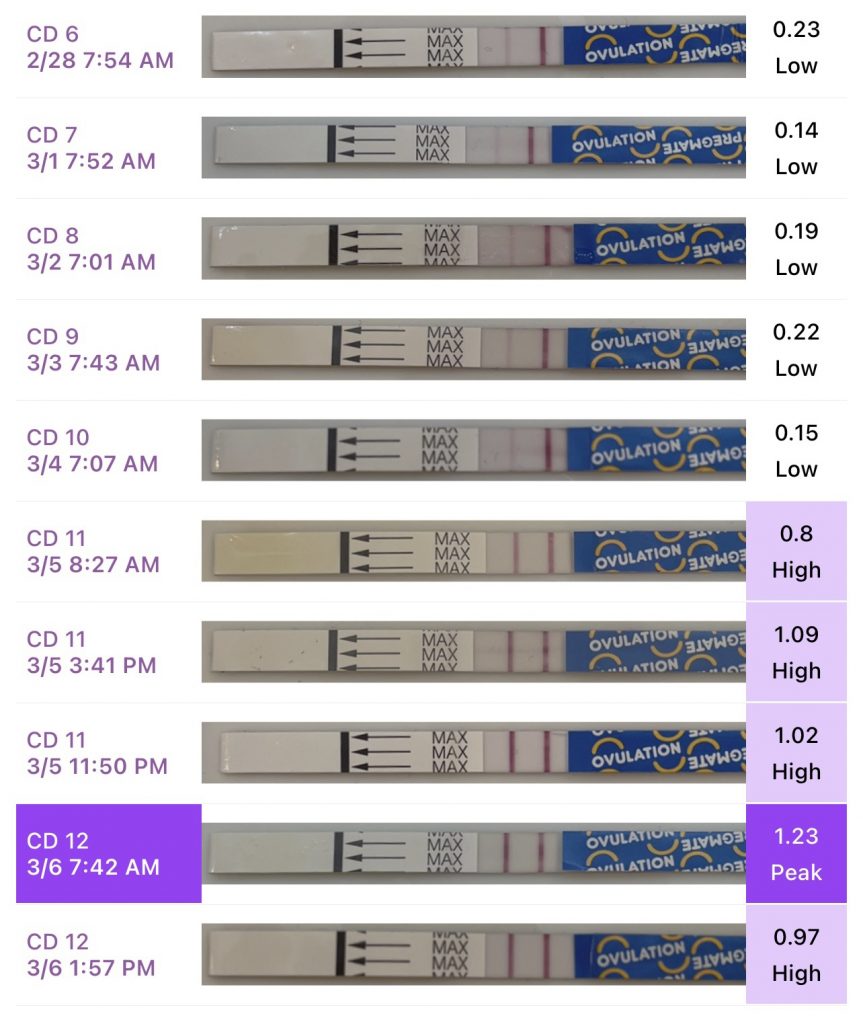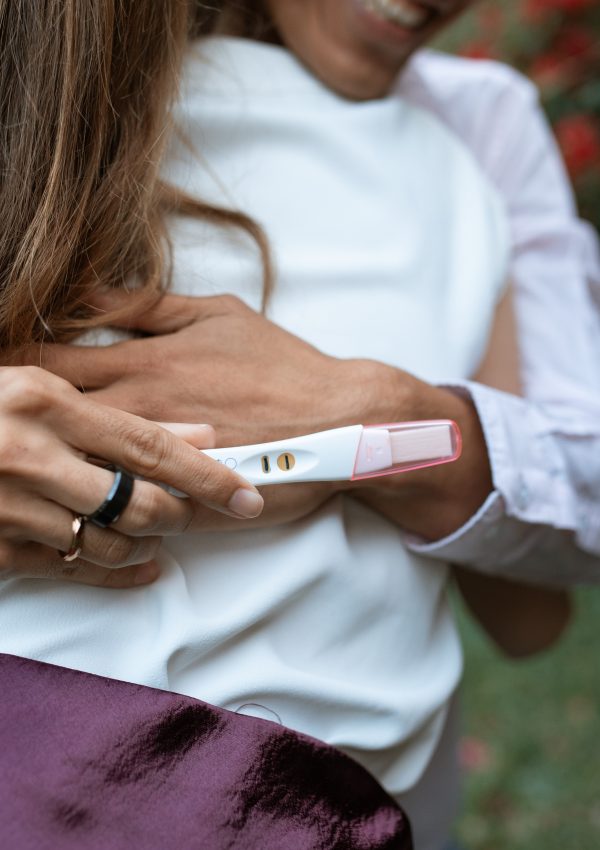Ovulation tests are an incredibly useful tools when trying to conceive. There are different types and they all have different ways of interpreting results. So, how can you tell if your ovulation test is positive?
You can tell if your ovulation test is positive depending on whether you’re using a digital test or a an ovulation test strip. Digital ovulation tests typically show a positive result with a solid smiley face or other symbol. An ovulation test trip is positive if the test line is equal to or darker than the control line.

What Is An Ovulation Test?
An ovulation test is a tool that you can use to measure a hormone called LH (lutenizing hormone). This hormone usually spikes right before ovulation and is what triggers the egg to release from the ovary. Ovulation tests work by measuring your LH levels through urine, similarly to how you would take a pregnancy test.
The Digital Ovulation Test vs. The Ovulation Test Strip
Digital Ovulation Test
Digital ovulation tests are a type of ovulation test that show you your results digitally. They are typically more expensive but present results that are easier to interpret. Some of the most common ones are the Clearblue Advanced Digital Ovulation Test and the Clearblue Digital Ovulation Test.
Both digital tests will show you a positive result with a solid smiley face. The main difference is that the advanced version will show you a blinking smiley face when you’re considered fertile. The regular digital version only shows a solid smiley face when your LH levels have surged.
Ovulation Test Strip
Ovulation test strips are cheaper and but will show you your results using lines. You’ll have to compare your test line to the control line and see which one is darker. For example, below are my results using the Pregmate Ovulation Test Strips when I was trying to conceive my second baby. I uploaded my results to the Premom App for easier interpretation:

To be clear, uploading your results to an app is not necessary, it’s just an extra step you can take to see your results more clearly. Any of the last 4 pictures I would’ve considered positive because the test line is equal to or darker than the control line.
How To Use An Ovulation Test
You use an ovulation test by peeing in a cup (after at least a 4 hour hold) and dipping the test in. It’s usually best to take an ovulation test first thing in the morning, but you can take one at other times of the day as long you’ve been holding your pee for at least 4 hours.
The 4 hour “rule” is so that your urine isn’t too diluted at the time of taking the test, which can skew your results. The digital tests may require you dip the test in the urine for about 20 seconds, where as the test strips only require you to it for 5-10 seconds.
The digital tests will also take a few minutes to calculate the results and the test strips usually show you your results within seconds.
What To Do When Your Ovulation Test Is Positive
When your ovulation test is positive, there is only one thing to do: have intercourse.
The best part about these ovulation tests is that they tell you when you’re about to ovulate, not when you’re already ovulating. So having intercourse when you see that positive result is perfect timing to try to get pregnant. Typically, you 12 to 36 hours between your positive result and when you actually ovulate.
Can You Test Positive More Than Once?
If you’re using the ovulation test strips, yes. In my screenshot of ovulation tests above, you can see that the last 4 pictures look roughly the same. Even though the app identified one as the “peak” reading, the last 4 are positive results because the test line is equal to or darker than the control line.
If you’re using a digital test, you shouldn’t get more than 1 positive result per cycle. The digital tests work by establishing a baseline of your hormone levels and the reader remembers your results everyday. If you miss a day, it essentially resets the baseline so your results for the remainder of that cycle may not be accurate.
Furthermore, the digital tests often instruct you to stop testing once you receive your positive result. So once you receive your positive, don’t test again until your next cycle.
What If You’ve Been Testing For Days and Haven’t Received A Positive?

There are a few reasons you wouldn’t get a positive result on an ovulation test:
- You’re taking tests without waiting long enough in between them
- You’re using the tests incorrectly
- You have irregular cycles
- You have an underlying medical condition like PCOS
- You’re on certain medications
All 5 of these factors could possibly prevent you from getting a positive result. The digital tests are more sensitive to these kinds of factors because of the technology behind them.
A fertility condition like PCOS can cause a hormonal imbalance that causes you to ovulate less or not at all. It’s best to reach out to your physician if you think you have it so they can run a few tests to confirm.
Irregular cycles could also be a reason you don’t get a positive result because you may never actually be sure when you ovulate. And lastly, certain medications like antibiotics and birth control can throw off your hormone levels and prevent you from ovulating.
How Long After A Positive Ovulation Test Are You Fertile?
After a positive ovulation test, you’re only fertile for the next 2 days max. Why? Because you typically ovulate a day after your positive result and after that the egg only lives for about a day. Once the egg dies, you can no longer get pregnant that cycle.
This is why it’s advised to have intercourse in the days leading up to ovulation. Your most fertile time in any given cycle is between when your period ends and when you ovulate.
Can You Use An Ovulation Test To Test For Pregnancy?
Ovulation tests aren’t made to test for pregnancy so the short answer is no. The only way to confirm pregnancy is with a pregnancy test.
What Are The Chances of Getting Pregnant After A Positive Ovulation Test?
In this study, the average pregnancy rate on the day before ovulation (when you’d get a positive result) is 36%, which is pretty high. Obviously there are different factors that can impact your chances individually. However, if you have no underlying fertility conditions and have a regular cycle, your chances are decent in any given cycle.
Summary
Overall, ovulation tests are an extremely useful, cost-effective tool to try while trying to conceive. You can tell they’re positive when the test line is darker than the control line, or if a solid smiley face pops up on the digital test. Ovulation tests don’t work for everyone so if you suspect something is wrong, it’s best to reach out to your doctor to get to the bottom of any issues.




